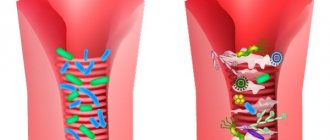Why does the bitter taste appear?
A bitter taste in the mouth appears due to the reflux of the contents of the duodenum into the stomach or esophagus and oral cavity.
This feeling is troubling not only because of gastrointestinal diseases. The reason may be the presence of an infection in the body, exposure to medications, insufficient oral hygiene, during pregnancy, due to a lack of vitamins, an excess of fried heavy foods, alcohol, and coffee drinks. Gum disease is accompanied by a feeling of taste in the mouth due to the growth of bacterial flora. With dentures and poor oral hygiene, bacteria accumulate, multiply, and a bitter taste appears in the mouth.
When taking chemotherapy drugs, antibiotics, or antihistamines, bitterness in the mouth can be a side effect.
Dysgeusia is a taste disorder in which taste perception is altered. Dysgeusia can occur during pregnancy, in smokers, in older people, and in mental illness.
Klacid® SR
The use of the following drugs with clarithromycin is contraindicated due to the potential for serious side effects:
Cisapride, pimozide, terfenadine and astemizole
When clarithromycin was co-administered with cisapride, pimozide, terfenadine or astemizole, increased plasma concentrations of the latter were reported, which could lead to QT prolongation and cardiac arrhythmias, including ventricular tachycardia, ventricular fibrillation and torsade de pointes (TdP) (see section "Contraindications").
Ergot alkaloids
Post-marketing studies show that when clarithromycin is used together with ergotamine or dihydroergotamine, the following effects associated with acute poisoning with ergotamine drugs are possible: vascular spasm, ischemia of the limbs and other tissues, including the central nervous system. Concomitant use of clarithromycin with ergot alkaloids is contraindicated (see section "Contraindications").
Midazolam for oral use
When midazolam was coadministered with clarithromycin tablets (500 mg twice daily), midazolam AUC increased 7-fold after oral administration. Concomitant use of clarithromycin with oral midazolam is contraindicated (see section "Contraindications").
HMG-CoA reductase inhibitors (statins)
Concomitant use of clarithromycin with lovastatin or simvastatin is contraindicated (see section "Contraindications") due to the fact that these statins are largely metabolized by the CYP3A4 isoenzyme, and combined use with clarithromycin increases their serum concentrations, which leads to an increased risk of developing myopathy, including Rhabdomyolysis
Cases of rhabdomyolysis have been reported in patients taking clarithromycin concomitantly with these drugs. If clarithromycin is necessary, lovastatin or simvastatin should be discontinued during therapy.
Clarithromycin should be used with caution in combination therapy with other statins. If coadministration is necessary, it is recommended to take the lowest dose of statin. It is recommended to use statins that do not depend on the metabolism of the CYP3A isoenzyme (for example, fluvastatin). The development of signs and symptoms of myopathy should be monitored.
Effect of other drugs on clarithromycin
Drugs that are inducers of the CYP3A isoenzyme (for example, rifampicin, phenytoin, carbamazepine, phenobarbital, St. John's wort) can induce the metabolism of clarithromycin. This may result in subtherapeutic concentrations of clarithromycin, resulting in reduced effectiveness.
In addition, it is necessary to monitor the concentration of the CYP3A inducer in the blood plasma, which may increase due to the inhibition of the CYP3A isoenzyme by clarithromycin. When rifabutin and clarithromycin were used together, an increase in plasma concentrations of rifabutin and a decrease in serum concentrations of clarithromycin were observed with an increased risk of developing uveitis.
The following drugs have a proven or suspected effect on clarithromycin plasma concentrations; if used concomitantly with clarithromycin, dosage adjustments or switching to alternative treatment may be required.
Efavirenz, nevirapine, rifampicin, rifabutin and rifapentine
Strong inducers of the cytochrome P450 system, such as efavirenz, nevirapine, rifampicin, rifabutin and rifapentine, can accelerate the metabolism of clarithromycin and, thus, reduce the concentration of clarithromycin in plasma and at the same time increase the concentration of 14-OH-clarithromycin, a metabolite that is also microbiologically active. Since the microbiological activity of clarithromycin and 14-OH-clarithromycin differs against different bacteria, the therapeutic effect may be reduced when clarithromycin is used together with enzyme inducers.
Etravirine
The concentration of clarithromycin decreases with the use of etravirine, but the concentration of the active metabolite 14-OH-clarithromycin increases. Because 14-OH-clarithromycin has little activity against Mycobacterium avium complex (MAC) infections, overall activity against these pathogens may be altered, and alternative treatments should be considered for the treatment of MAC.
Fluconazole
Coadministration of fluconazole 200 mg daily and clarithromycin 500 mg twice daily in 21 healthy volunteers resulted in an increase in mean clarithromycin minimum steady-state concentration (Cmin) and AUC by 33% and 18%, respectively. However, co-administration did not significantly affect the average steady-state concentration of the active metabolite 14-OH-clarithromycin. No dose adjustment of clarithromycin is required when taking fluconazole concomitantly.
Ritonavir
A pharmacokinetic study showed that coadministration of ritonavir 200 mg every eight hours and clarithromycin 500 mg every 12 hours resulted in a marked suppression of the metabolism of clarithromycin. When co-administered with ritonavir, clarithromycin Cmax increased by 31%, Cmin increased by 182% and AUC increased by 77%.
Almost complete suppression of the formation of 14-OH-clarithromycin was noted. Due to the wide therapeutic range of clarithromycin, dose reduction is not required in patients with normal renal function.
In patients with renal failure, it is advisable to consider the following dose adjustment options: with CC 30-60 ml/min, the dose of clarithromycin should be reduced by 50%. Ritonavir should not be co-administered with clarithromycin in doses exceeding 1 g/day.
Similar dosage adjustments should be considered in patients with reduced renal function if ritonavir is used as a pharmacokinetic enhancer when using other HIV protease inhibitors, including atazanavir and saquinavir (see section "Bidirectional Drug Interactions").
Effect of clarithromycin on other drugs
Antiarrhythmics (quinidine and disopyramide)
Ventricular tachycardia of the “pirouette” type may occur with the combined use of clarithromycin and quinidine or disopyramide.
When clarithromycin is coadministered with these drugs, the electrocardiogram should be regularly monitored for prolongation of the QT interval, and serum concentrations of these drugs should also be monitored.
During post-marketing use, cases of hypoglycemia have been reported during co-administration of clarithromycin and disopyramide. It is necessary to monitor the concentration of glucose in the blood while using clarithromycin and disopyramide.
Oral hypoglycemic agents/insulin
When clarithromycin is used together with oral hypoglycemic agents (for example, sulfonylureas) and/or insulin, severe hypoglycemia may occur.
Concomitant use of clarithromycin with certain hypoglycemic drugs (for example, nateglinide, pioglitazone, repaglinide and rosiglitazone) may lead to inhibition of the CYP3A isoenzyme by clarithromycin, which may result in hypoglycemia. Careful monitoring of glucose concentrations is recommended.
Interactions due to CYP3A isoenzyme
Co-administration of clarithromycin, which is known to inhibit the CYP3A isoenzyme, and drugs primarily metabolized by the CYP3A isoenzyme, may be associated with a mutual increase in their concentrations, which may increase or prolong both therapeutic and side effects.
Clarithromycin should be used with caution in patients receiving drugs that are substrates of the CYP3A isoenzyme, especially if these drugs have a narrow therapeutic index (for example, carbamazepine) and/or are extensively metabolized by this enzyme. If necessary, the dose of the drug taken together with clarithromycin should be adjusted. Also, whenever possible, serum concentrations of drugs primarily metabolized by the CYP3A isoenzyme should be monitored.
The following drugs/classes are metabolized by the same CYP3A isoenzyme as clarithromycin, e.g. alprazolam, carbamazepine, cilostazol, cyclosporine, disopyramide, methylprednisolone, midazolam, omeprazole, indirect anticoagulants (e.g. warfarin), atypical antipsychotics (e.g. quetiapine) , quinidine, rifabutin, sildenafil, tacrolimus, triazolam and vinblastine.
Also, agonists of the CYP3A isoenzyme include the following drugs that are contraindicated for combined use with clarithromycin: astemizole, cisapride, pimozide, terfenadine, lovastatin, simvastatin and ergot alkaloids (see section “Contraindications”).
Drugs that interact in this manner through other isoenzymes within the cytochrome P450 system include phenytoin, theophylline, and valproic acid.
Indirect anticoagulants
When taking warfarin and clarithromycin together, bleeding and a marked increase in INR and prothrombin time are possible. In case of combined use with warfarin or other indirect anticoagulants, it is necessary to monitor the INR and prothrombin time.
Omeprazole
Clarithromycin (500 mg every 8 hours) was studied in healthy adult volunteers in combination with omeprazole (40 mg daily). When clarithromycin and omeprazole were co-administered, steady-state plasma concentrations of omeprazole were increased (Cmax, AUC0-24 and T1/2 increased by 30%, 89% and 34%, respectively). The mean 24-hour gastric pH was 5.2 when omeprazole was taken alone and 5.7 when omeprazole was taken with clarithromycin.
Sildenafil, tadalafil and vardenafil
Each of these phosphodiesterase inhibitors is metabolized, at least in part, by the CYP3A isoenzyme. At the same time, the CYP3A isoenzyme can be inhibited in the presence of clarithromycin. Concomitant use of clarithromycin with sildenafil, tadalafil or vardenafil may result in increased phosphodiesterase inhibitory effects. When using these drugs together with clarithromycin, consider reducing the dose of sildenafil, tadalafil and vardenafil.
Theophylline, carbamazepine
When clarithromycin and theophylline or carbamazepine are used together, the concentration of these drugs in the systemic circulation may increase.
Tolterodine
The primary metabolism of tolterodine occurs through the 2D6 isoform of cytochrome P450 (CYP2D6). However, in part of the population lacking the CYP2D6 isoenzyme, metabolism occurs through the CYP3A isoenzyme. In this population, inhibition of CYP3A results in significantly higher serum tolterodine concentrations. In populations that are poor metabolizers of CYP2D6, a dose reduction of tolterodine may be required in the presence of CYP3A inhibitors such as clarithromycin.
Benzodiazepines (eg, alprazolam, midazolam, triazolam)
When midazolam was co-administered with clarithromycin tablets (500 mg twice daily), midazolam AUC increased by 2.7 times after intravenous midazolam administration. If intravenous midazolam is used concomitantly with clarithromycin, the patient's condition should be carefully monitored for possible dose adjustment.
Administration of a drug through the oral mucosa, which bypasses presystemic drug elimination, is likely to result in an interaction similar to that observed with intravenous midazolam rather than with oral administration.
The same precautions should be applied to other benzodiazepines that are metabolized by CYP3A, including triazolam and alprazolam. For benzodiazepines whose elimination is not dependent on the CYP3A isoenzyme (temazepam, nitrazepam, lorazepam), a clinically significant interaction with clarithromycin is unlikely.
When clarithromycin and triazolam are used together, effects on the central nervous system (CNS), such as drowsiness and confusion, are possible. Therefore, if coadministration occurs, it is recommended to monitor for symptoms of CNS impairment.
Interactions with other drugs
Colchicine
Colchicine is a substrate of both the CYP3A isoenzyme and the transport protein P-glycoprotein (Pgp). It is known that clarithromycin and other macrolides are inhibitors of the CYP3A and Pgp isoenzymes. When clarithromycin and colchicine are taken together, inhibition of Pgp and/or CYP3A may result in increased effects of colchicine. There have been post-marketing reports of cases of colchicine poisoning when taken concomitantly with clarithromycin, most often in elderly patients with renal failure. Some cases were reported to be fatal. The simultaneous use of clarithromycin and colchicine is contraindicated (see section "Contraindications").
Digoxin
Digoxin is suspected to be a Pgp substrate. Clarithromycin is known to inhibit Pgp. When clarithromycin and digoxin are co-administered, inhibition of Pgp by clarithromycin may result in increased effects of digoxin.
Post-marketing studies have shown that coadministration of digoxin and clarithromycin may also result in increased serum concentrations of digoxin. Some patients have experienced clinical symptoms of digoxin toxicity, including potentially fatal arrhythmias. Serum digoxin concentrations should be carefully monitored when clarithromycin and digoxin are coadministered.
Zidovudine
Concomitant use of clarithromycin tablets and oral zidovudine by adult HIV-infected patients may result in decreased steady-state zidovudine concentrations.
Because clarithromycin interferes with the oral absorption of zidovudine, the interaction can be largely avoided by taking clarithromycin and zidovudine 4 hours apart.
This interaction was not observed in HIV-infected children taking clarithromycin pediatric suspension with zidovudine or dideoxyinosine. Since clarithromycin may interfere with the absorption of zidovudine when administered concomitantly orally in adult patients, such an interaction is unlikely to occur when clarithromycin is used intravenously.
Phenytoin and valproic acid
There is evidence of interactions between CYP3A inhibitors (including clarithromycin) and drugs that are not metabolized by CYP3A (phenytoin and valproic acid). For these drugs, when used together with clarithromycin, it is recommended to determine their serum concentrations, as there are reports of their increase.
Bidirectional drug interactions
Atazanavir
Clarithromycin and atazanavir are both substrates and inhibitors of the CYP3A isoenzyme. There is evidence of a bidirectional interaction between these drugs. Coadministration of clarithromycin (500 mg twice daily) and atazanavir (400 mg once daily) may result in a twofold increase in clarithromycin exposure and a 70% decrease in 14-OH-clarithromycin exposure, with a 28% increase in atazanavir AUC. Due to the wide therapeutic range of clarithromycin, dose reduction is not required in patients with normal renal function.
In patients with moderate renal failure (creatinine clearance 30-60 ml/min), the dose of clarithromycin should be reduced by 50%. In patients with CC less than 30 ml/min, the dose of clarithromycin should be reduced by 75% using the appropriate dosage form of clarithromycin.
Clarithromycin in doses exceeding 1000 mg per day should not be used in conjunction with protease inhibitors.
Blockers of "slow" calcium channels
When using clarithromycin simultaneously with blockers of “slow” calcium channels that are metabolized by the CYP3A4 isoenzyme (for example, verapamil, amlodipine, diltiazem), caution should be exercised as there is a risk of arterial hypotension. Plasma concentrations of clarithromycin, as well as slow calcium channel blockers, may increase with simultaneous use. Arterial hypotension, bradyarrhythmia and lactic acidosis are possible when taking clarithromycin and verapamil simultaneously.
Itraconazole
Clarithromycin and itraconazole are substrates and inhibitors of the CYP3A isoenzyme, which determines the bidirectional interaction of the drugs. Clarithromycin may increase plasma concentrations of itraconazole, while itraconazole may increase plasma concentrations of clarithromycin.
Patients taking itraconazole and clarithromycin concomitantly should be closely monitored for symptoms of increased or prolonged pharmacological effects of these drugs.
Saquinavir
Clarithromycin and saquinavir are substrates and inhibitors of the CYP3A isoenzyme, which determines the bidirectional interaction of the drugs. Coadministration of clarithromycin (500 mg twice daily) and saquinavir (soft gelatin capsules, 1200 mg three times daily) in 12 healthy volunteers increased the AUC and Cmax of saquinavir by 177% and 187%, respectively, compared with saquinavir alone. . The AUC and Cmax values of clarithromycin were approximately 40% higher than with clarithromycin monotherapy.
When these two drugs are used together for a limited time at the doses/formulations indicated above, no dose adjustment is required. Results from drug interaction studies using saquinavir soft gelatin capsules may not be consistent with the effects observed with saquinavir hard gelatin capsules.
The results of drug interaction studies with saquinavir monotherapy may not be consistent with the effects observed with saquinarine/ritonavir therapy. When taking saquinavir with ritonavir, consider the potential effect of ritonavir on clarithromycin.
How to get rid of bitterness in your mouth
Treatment depends on the diagnosis.
If these are diseases of the gastrointestinal tract (gallbladder, pancreas, liver), then the doctor prescribes drug therapy and dietary nutrition. Medicines used include choleretic drugs, antibiotics, antispasmodics for pain, prokinetics for synchronous functioning of the gallbladder and ducts, and sedatives. If bitterness in the mouth appears after eating fatty, fried, spicy foods, then it is necessary to adjust the diet and introduce healthy foods into the diet.
If you have GERD, you must follow some recommendations - do not lie down after eating for half an hour, do not bend over after eating, do not wear tight clothes that compress the stomach, sleep with the head of the bed raised.
How to cope with dysbiosis?
If you experience an unpleasant taste in your mouth while taking antibacterial drugs, you should inform your doctor. Perhaps he will change the drug or adjust the dosage. If this does not help, it is necessary to restore the balance of the intestinal microflora. Proper nutrition will help remove bitterness in the mouth after antibiotics and normalize the functioning of the gastrointestinal tract. The diet should include:
- fermented milk products - natural yoghurts without additives, kefir, yogurt,
- cereals,
- fresh herbs - parsley, celery,
- fruits and berries,
- garlic and onion.
If there are signs of dysbacteriosis, you should avoid fatty meats, sweets and baked goods, and foods that increase gas formation. They are slowly digested and poorly absorbed. Such food overloads the stomach and can cause intestinal disorders.
Diet
The diet should include soft, well-chopped food. Gentle cooking methods - steam, bake, boil, stew. Include puree soups and cream soup in your diet. Bread can be consumed dried, yesterday's bread made from first and second grade flour. Meat – chicken, turkey, lean parts of beef, lean fish. Eggs should be in the form of omelettes, steamed in the oven. Food should be warm, not cold or hot. If there is a symptom of bitterness in the mouth, it is necessary to exclude sausages, smoked foods, fatty, fried, canned, and pickled foods from the diet. It is completely necessary to exclude alcohol, spicy foods, coffee, chocolate, carbonated drinks, pork, and some legumes.











